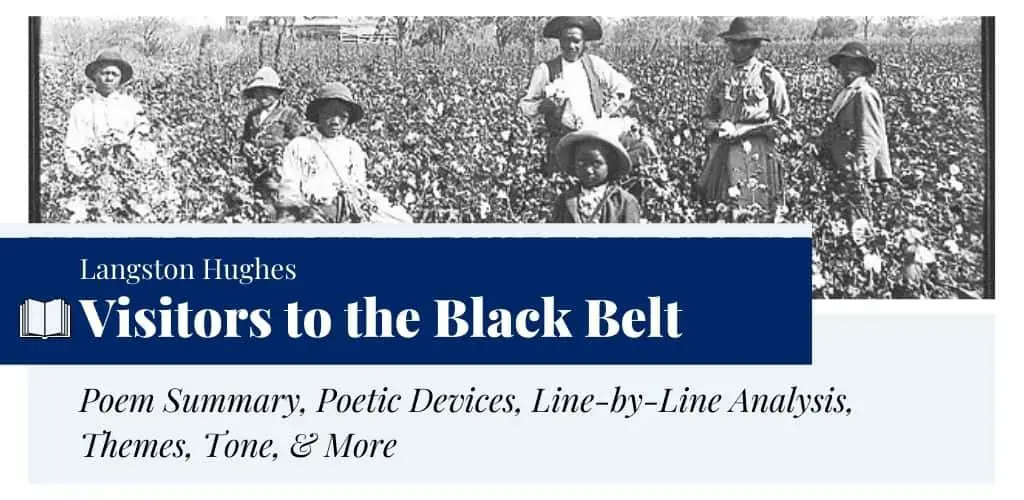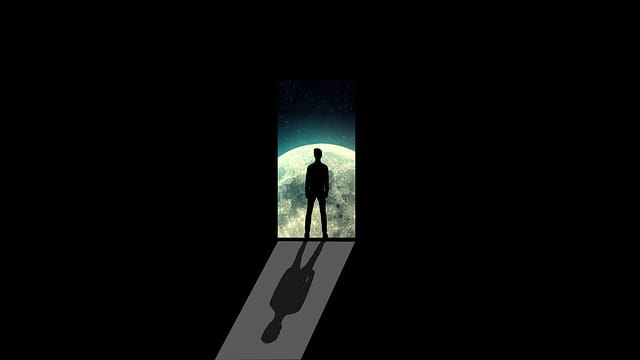Visitors to the Black Belt by Langston Hughes
“Visitors to the Black Belt” is a poem written by the African-American poet Langston Hughes, which appears in the 1994 publication The Collected Poems of Langston Hughes. The poem deals with the realities of the lives of African-American individuals in early 20th-century America. It breaks the romanticized and whitewashed perspectives of Black lives seen through the white oppressors’ gaze. Hughes, in this short poem, points out how the realities of Black people stand in stark contrast to the dominant upper-class white perception of them from the “outside” world.
- Read the full text of “Visitors to the Black Belt” below:
Visitors to the Black Belt by Langston Hughes You can talk about Across the railroad tracks— To me it's here On this side of the tracks. You can talk about Up in Harlem— To me it's here In Harlem. You can say Jazz on the South Side— To me it's hell On the South Side: Kitchenettes With no heat And garbage In the halls. Who're you, outsider? Ask me who am I.

Summary
In “Visitors to the Black Belt,” the speaker, who represents the African-American community, addresses the dominant “white” people, who have biased, preconceived notions about the lifestyle of Black individuals. He breaks down the various distorted and ignorant views that they usually perpetrate and points out the actual lived realities that are very different from the “rosy” picture painted by white people. He says white people can talk about Black lives as distant from them, “…across the railroad tracks—”; however, the speaker actually lives on the other side, which is not as happy as they make it out to be.
The speaker calls such people “outsiders,” as they romanticize the positive aspects of Black culture but, at the same time, choose to conveniently ignore the socio-economic struggles that they have to undergo. As the poet says, they overlook the “kitchenettes with no heat” and “garbage in the halls” – aspects which are far too real for the speaker.
Meaning
“Visitors to the Black Belt” can be seen as a poem of resistance, which Langston Hughes is renowned for. He breaks down the racial binaries perpetrated by white people by pointing out ironic binaries of illusion vs. reality and questions the ignorant beliefs that keep Black individuals oppressed. The speaker articulates how a white upper-class person can afford to distance himself from the Black lives he talks about but knows nothing of the hardships the speaker and his community actually have to endure, which have been the result of racial segregation practiced by these very individuals.
While the dominant oppressor can speak of the glorious African-American culture in Harlem and revel in the jazz music that Black communities produced, they choose not to talk of the poverty, deprivation, and marginalization that is an everyday fact for African-American communities. They conveniently ignore the problems racism has created and choose instead to appropriate and romanticize Black lifestyles without ever delving beyond a surface-level understanding.
Structure & Form
“Visitors to the Black Belt” is a short lyric poem. Hughes was a modernist poet, and therefore his poetry is quite experimental. He incorporates various styles that trace back to his African lineage, and the unique use of rhythm in his poetry is musical and melodic. He is credited as one of the most excellent practitioners of jazz poetry, which combines the literary form of poetry with the musical stylizations of jazz.
While the poem does not have a fixed metrical structure, it does have a deep rhythmic effect characteristic of Hughes. Most of the rhyme in the poem is achieved through identical rhymes, which is the practice of using identical words to achieve a rhyming pattern. For example, “Jazz on the South Side—/ To me it’s hell/ On the South Side:”
Hughes also deviates from strict ideas of versification like stanza lines. The last two lines stand alone, apart from any other stanza. The stanzas that precede also do not follow consistent lengths. Hughes also suddenly breaks from consistent meter to shock the readers into focusing their attention on what follows. This is seen in “Kit-che-nettes/ With no heat/ And gar-bage/ In the halls.”
Poetic Devices
In “Visitors to the Black Belt,” Hughes makes use of the following poetic devices:
- Antithesis: Ideas opposite to illusion and consonant with reality are central to the poem. This can be found in “Across the railroad tracks—/ To me it’s here/ On this side of the tracks.”
- Repetition: Words like “tracks,” “Harlem,” and “South Side” are repeated for internal rhyming. The phrase “To me” is repeated at the beginning of the third line in all three stanzas for poetic effect.
- Oxymoron: This can be seen in opposing ideas like “Kitchenettes/ With no heat.”
- Enjambment: There are multiple run-on lines that maintain the continuity of the poem; for instance, “You can talk about/ Up in Harlem—”.
- Allusion: In this poem, Hughes alludes to the social history of the Black people living in the South through the phrase “Black Belt.”
- Rhetorical Question: Hughes employs this device in “Who’re you, outsider?” – to make his idea more pertinent.
Line-by-Line Analysis & Explanation
Lines 1-4
You can talk about
Across the railroad tracks—
To me it’s here
On this side of the tracks.
In the first four lines of “Visitors to the Black Belt,” the speaker establishes the central binaries of “the dominant” (the white upper-class) and “the other” (African-American people). However, he also subverts these notions by questioning the “powerful” and therefore making “the self” emerge strongly in the poem. He addresses the oppressor and calls out their privileged position in society. He says the communities that white people dismissively refer to as being “Across the railroad tracks—” might be distant to them. However, it is where the speaker and hundreds of other Black people reside. That is their own home, and no one except them knows better what conditions they live in.
The reference to “Across the railroad tracks—” is a reference to the racial segregation law, “Jim Crow laws” that the oppressor white brought in to create separate Black spaces systematically. The settlements of white and black individuals, as indicated by this poem, seem to be separated by a symbolic railroad track. It stands for the estranging notions that still bar the Blacks from entering the mainstream dominated by whites.
Lines 5-8
You can talk about
Up in Harlem—
To me it’s here
In Harlem.
The next lines of “Visitors to the Black Belt” continue the same idea of “the dominant” and “the other,” however, Hughes brings out a strong voice of resistance that fights back at the notions created by white people. Harlem, in New York City, was a place that witnessed the emergence of intellectual, artistic, musical, and cultural revolution among the Black community, known as the Harlem Renaissance. Hughes was at the forefront of this intellectual and cultural revival.
In this poem, the reference indicates the cultural appropriation of the Harlem movement that white people practice. Also, the fact that they refer casually to the culture and the music produced in Harlem without considering the actual spirit of revolution and the oppression that African-American people fought against through the movement.
Also, it is essential to note that Harlem became an area that witnessed the influx of a substantial Black population from the Black Belt during the early 20th-century to find economic upliftment and opportunities. So, this reference has a dual meaning. The speaker points out how white people possibly refer to Black culture and life in the Harlem area, but for the speaker, Harlem is where he belongs; it is where his roots are.
Lines 9-16
You can say
Jazz on the South Side—
To me it’s hell
On the South Side:
Kitchenettes
With no heat
And garbage
In the halls.
The third stanza articulates the actual struggles and hardships of Black people in the 1900s. The speaker points out how it is easy for the dominant group to live in their privileged bubbles. They enjoy the music composed by Black people and listen to jazz performances from the “South Side.” The reference to “Jazz” is significant as it was one of the most important forms of music that were invented and practiced by Black people as a part of the Harlem Renaissance.
However, the speaker says, white individuals are utterly clueless about the economic and social deprivation that racism and segregation have caused to Black people. While white individuals can go on living their lives unaffected by the oppressive systems in place, it is Black individuals who suffer the effects of marginalization every day. As Hughes points out, the reality of Black people’s lives is not just the rich culture of jazz music. It also includes the images of their kitchenettes without proper heat and their harsh living condition.
The highly romanticized and one-dimensional view of African-American lives by the dominant white is questioned in this stanza as the economic poverty, and pitiable conditions are not visible to the oppressor’s gaze.
Lines 17-18
Who’re you, outsider?
Ask me who am I.
The last two lines wind up the central themes and ideas of “Visitors to the Black Belt.” While in the previous lines, the speaker showed the distinctions in the lives and perceptions of the two groups. In these lines, he directly questions the oppressive white upper-class sensibilities. The rhetorical question becomes very important, as he subverts the idea of “the other” to mean “the white.” By calling them “outsider[s],” Hughes points out how away from Black sensibilities and thoughts they are. This line asserts that a white person will never have the same experiences and hardships a Black person has to endure due to racism.
However, this can also be interpreted as the speaker claiming oneness with his movement and his people by saying white people can try as they might. Still, they can never take away the familial bond and the spirit of resistance of the African-American community.
In the last line, the speaker proudly says, “Ask me who am I,” which again strengthens the idea of lived experiences as being different than romanticized, narrow perspectives that are propagated by the powerful, which they will never understand.
Themes
The first central theme in the poem is romanticization versus reality, and Hughes embodies the idea of lived reality. Hughes’ speaker points out the disparity between the privileged white lives and the oppressed Black lives, and the idea of binaries becomes significant in the text. The powerful, ignorant white choose to romanticize certain aspects of African-American culture and appropriate it too; however, they conveniently sideline their struggles and oppression. They reduce Black lives to the positive aspects they see but fail to recognize the harm they have caused due to systemic racism, segregation, and racial violence.
Another major theme in the poem is the horrors of racial injustice and the economic, social, and political marginalization that occurred, especially in the American South referred to as the “Black Belt.” The speaker points out the various hardships of African-American lives, including unsanitary living spaces and inadequate resources for sustenance. However, while white people have been at the center of these evils and have taken away the human rights of Black people, they still seem to be blithely unaware of these effects and continue to be highly stereotypical and unidimensional in their views of Black lifestyle and culture.
Tone
The poem “Visitors to the Black Belt” is written in the first-person point-of-view, and that strengthens the tone of resistance that becomes apparent in the entire text. Hughes also takes a very realistic tone throughout the poem, which subverts the illusionary picture painted by the dominant group. The powerful, defiant way through which the speaker questions the ignorant, oppressive stance of white people becomes highly significant to the revolutionary nature of the poem. The absence of optimism throughout the poem is another way of emphasizing the harsh realities of Black lives, which is the direct result of racial injustices. However, this piece emphasizes resistance by highlighting the ideas of racial consciousness, oneness, and toughness.
Questions & Answers
Langston Hughes’ “Visitors to the Black Belt” is about the ignorant and privileged worldviews that the oppressive white upper-class perpetuates about Black people’s lives and culture, and how the actual lived realities of African American people are entirely different from them, full of hardships and struggles.
The major themes in the poem are perception versus reality, race and racism, the struggles and realities of the lives of the African American people, social and economic inequalities, resistance, privilege, etc.
Some poetic devices used in the poem are antithesis, repetition, oxymoron, enjambment, and rhetorical question.
Historical Context
Langston Hughes (February 1, 1901 – May 22, 1967) was an influential African-American poet, novelist, and playwright. He contributed immensely to the African-American cultural and intellectual revival, the Harlem Renaissance, and was also one of the leading proponents of jazz poetry. The poem “Visitors to the Black Belt” is written in the wake of racial injustices, white oppression, and stereotypes about Black lives during the late 19th and early 20th centuries. Hughes always took up a powerful voice of resistance and fought against white supremacy, celebrating African-American glory. His poem contains references to the important cultural movement that started in the 1920s called the Harlem Renaissance, which celebrated visual arts, theatre, music, literature, and culture that belonged to the Black community.
Similar Poems about Identity & Racial Consciousness
- “Song for a Dark Girl” by Langston Hughes — This poem deals with violent racism, African-American lives, the horrors of lynching, and white oppression.
- “To a Dark Girl” by Gwendolyn Bennett — This piece celebrates racial pride and carries the essence of the Harlem Renaissance.
- “The Black Family Pledge” by Maya Angelou — In this poem, Angelou talks about the glory of African-American resistance and the rich history of Black resistance that every Black family should revisit to guide their future generation.
- “As I Grew Older” by Langston Hughes — This piece explores the dreams of African-American youth and his struggles to achieve them.
External Resources
- History of the Black Belt — Learn about the social history of the Black Belt in the American South.
- Why Does Harlem Renaissance Matter? — Read about the Harlem Renaissance, a significant artistic and intellectual movement celebrating African-American lives and culture.
- About African-American Literature — Learn about the history and evolution of African-American literature of resistance and revolution.
- About Langston Hughes — Read about Hughes’ life and explore some of Hughes’ best-known poems.


